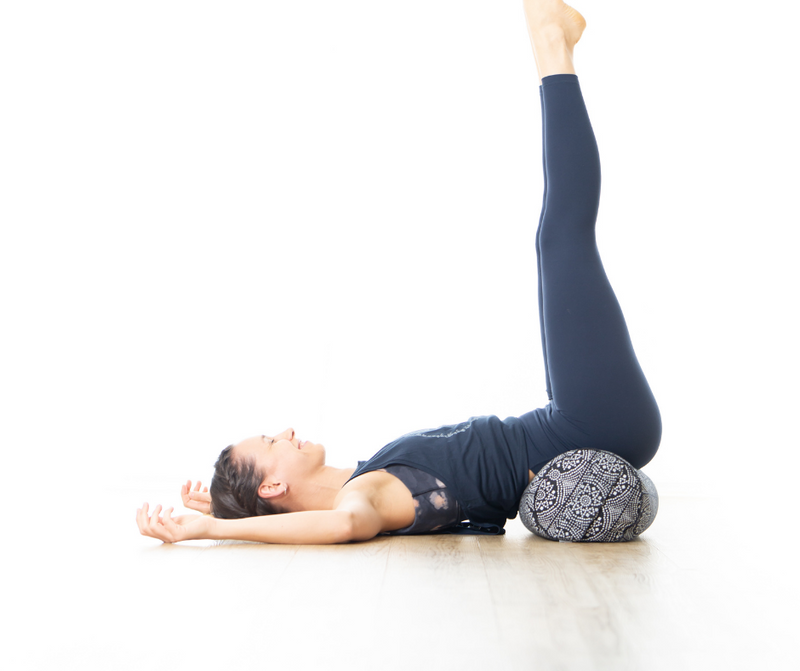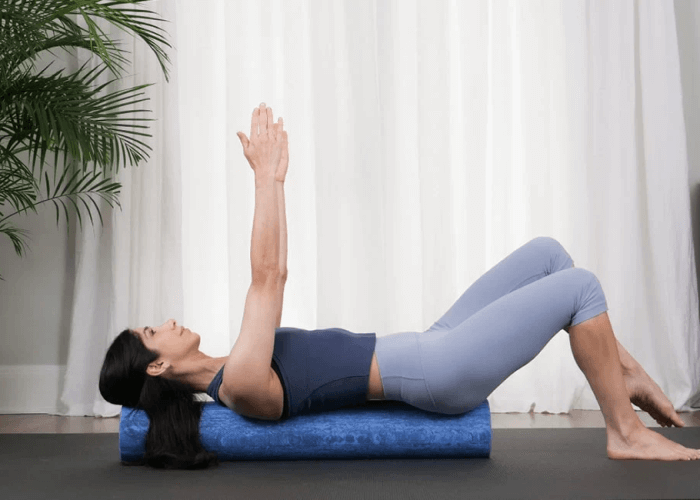3 Restorative Yoga Poses for Stress Relief At Home

We live in a society that prizes doing over being. We’re not taught the value of rest, and instead, we often find ourselves still stressed and anxious trying to do it all without slowing down to reconnect with ourselves.
It’s why most of us have the same problem when it comes to meditation. Our minds are trained to be active and tend to resist the idea of being quiet.
Bridging the gap between overactive thoughts and complete stillness, restorative yoga poses help you achieve a calm mental and physical state while also releasing tension in your muscles and tissues.
Restorative Yoga vs. Traditional Yoga
If you often turn to very active and challenging yoga classes or other physically demanding movement styles to relieve stress, you may be surprised at the power of restorative yoga poses.
Restorative yoga is similar to other types of yoga but is performed at a slower and more gentle pace to calm the mind rather than challenge the body, as with more athletic styles (like vinyasa, Hatha, or ashtanga) that focus on moving relatively quickly from one pose to another.
In contrast to most forms of yoga, restorative yoga focuses on long holds and uses more props, which allows your muscles to let go of any tension. With the use of mulitple props like blankets, bolsters, and blocks, the joints of the body are completely supported and send signals of safety to our brains.
This is how our brains receive the information to balance the chemicals and hormones in our bodies. Reducing damaging cortisol in the body is an important benefit to our health through restorative yoga poses.
Benefits of Restorative Yoga Poses
Restorative yoga is helpful when you need to turn off your mind.
As the body melts into relaxation, the mind is more able to quiet the busy and often negative messages we have playing on repeat.
Some find it a great time to replace those messages with more positive and kind words during the holding of the pose. Others find it more relaxing to simply mindfully notice their breath.
Here are more science-backed benefits of restorative yoga:
- Mind-Body Stress Reduction. Restorative yoga reduces anxiety and stress and lowers levels of the hormone cortisol, known as the “stress hormone.”
- Soothes the nervous system. Restorative yoga calms the nervous system and helps shift the balance from fight-or-flight (the sympathetic nervous system) to the relaxation response (the parasympathetic nervous system).
- Reduces Chronic Pain. Studies have shown that restorative yoga helps reduce pain associated with headache, back pain, and osteoarthritis.
- Strengthens the Immune System: Yoga reduces stress hormones in the body and strengthens the immune system. Stress is one of the leading causes of weakened immunity. Yoga calms the nervous system and conditions the respiratory tract, lungs, and lymphatic system.
- Improves Sleep: Studies have shown that yoga can improve the quality of your sleep.
3 Restorative Yoga Poses For Stress
Restorative yoga is a therapeutic practice that involves poses or asanas held for longer periods of time and are done with the support of blocks, bolsters, pillows, and blankets.
The goal is to feel as little sensation as possible — a deep stretch would be considered too intense for this practice.
Here are three restorative yoga poses to relieve stress at home. Aim to hold these poses for five minutes or more.
-
Reclining Bound Angle Pose (Supta Baddha Konasana)
Reclining Bound Angle Pose is one of the few yoga postures that is suitable and may be beneficial to do soon after eating a meal. The posture promotes the gentle expansion of the abdomen, creating better blood flow and digestion.
Its benefits include increased vitality of the digestive and reproductive organs, and can relieve PMS symptoms, stimulate kidney and bladder meridians, and relax hip flexors.
- Lay your spine on a bolster from the back of the pelvis up, making sure the head is fully supported.
- Place another folded towel or small blanket under the head to keep the ears in line with your shoulders.
- Bring the soles of the feet together and allow the knees to open and lower towards the floor.
- Place a yoga block or folded blanket under each knee so that you do not feel any stretching sensation or strain in the groin or inner thighs.
- Open the arms out to the sides; palms face up.
Hold here for 5-20 minutes, breathing gently with your eyes closed.
2. Supported Child’s Pose (Salamba Balasana)
Adding a bolster or pillows to Child’s Pose allows this familiar yoga asana to relax your nervous system. One of the forward-bending yoga postures, it gently stretches the hips and lower back while concentrating the breath into the backside of the lungs. It’s a soothing pose that supports and softens our heart and belly areas.
- Gather several blankets, a bolster, or even throw pillows from your sofa. It may take a little experimenting to find just the right support height.
- Nestle your prop(s) from your pelvis up to your head and a little beyond.
- Rest your forearms on the floor next to you and gently turn your head to one side. You may need to pull your bolster, pillows, or blankets closer to your pelvis or maybe further away.
- Once you find your perfect setup, close your eyes and allow your body to be fully supported, noticing your breath flowing gently in and out.
- Turn your head to the other side after a few minutes to have an even stretch on both sides of your neck.
- When you want to come out of the pose, slowly roll up through your spine, taking your time to come upright.
3. Legs Up A Wall (Viparita Karani)
An inversion pose, Legs Up a Wall gives the body many of the benefits of head or shoulder stands without straining the neck or shoulders. Bringing the legs above the heart improves circulation of blood and fluids from the lower legs and reduces swelling.
While its reputation as a cure-all may be exaggerated, Viparita Karani is a calming, stress-reducing pose that can be done once or twice a day.
Plus, doing it close to bedtime may improve sleep quality.
- Have a blanket or mat perpendicular to a wall.
- Lay down on your side and bring your bum as close to the wall as possible. Lay on your back and take your legs up the wall. If you feel a big stretch in the backs of your legs, scoot back from the wall until that sensation subsides.
- Allow your knees to bend slightly so that they’re not hyperextended. Bring a small folded towel or thin blanket under your head, so your ears are in line with your shoulders.
- If you have a yoga strap on hand, tie it around your thighs above your knees, placing the buckle between the legs rather than on the side.
- Relax here for several minutes. You can stay here 5-15 minutes, but be sure to lower the legs if the sensation intensifies.
- The goal is to have little to no sensation and to completely relax, so come out of the pose slowly and gently when your body signals to do so.
Restorative yoga is the perfect way to return to being instead of constantly doing. It allows your body the time to unwind and relax, which deepens your mind-body connection and wellbeing.
You can make these restorative yoga poses a daily practice at home, which will help you turn off your racing mind and bring harmony back into your life.
You can try out guided restorative yoga— and other self-care classes in our on-demand library — by signing up for the 7-day free membership trial here.
Let's Stay In Touch!




